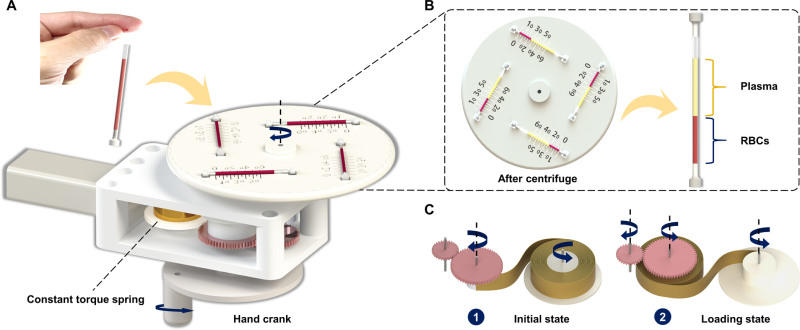Music Box-Inspired Semi-Automatic Hematocrit Validation Device
2023/8/31
According to the 2019 Global Burden of Disease Statistics, cardiovascular disease (CVD) causes nearly 18.6 million deaths annually, becoming one of the top ten causes of death worldwide. Furthermore, it accounts for more than 75% of deaths in low- and middle-developed countries, a phenomenon attributed to the lack of medical resources and access to healthcare. Generally, risk factors for CVDs include diabetes, hypertension, high blood pressure, high hematocrit, and increased blood viscosity. In severe cases, it may even lead to atherosclerosis and thromboembolization. Recent studies have focused on one of the parameters, the hematocrit (HCT), to verify its association with CVD.
The hematocrit, defined as the percentage of red blood cells in the blood, is an essential indicator of physiological health. It has been found to be highly correlated with many diseases and is an indispensable indicator of blood-related screening in clinical medicine. Typically, HCT levels in healthy individuals have been reported to be 45−52% in men and 37−48% in women. The gold standard for the HCT test is the hematology analyzer and centrifugal method. The hematology analyzer requires a blood cell counter to measure the HCT and additional hematologic information, which is based on the Coulter principle. The other approach utilizes microhematocrit centrifuges at high rotational speeds (12,000−15,000 rpm) to force the blood cells to sediment and separate rapidly to obtain the HCT from the centrifuged results. However, these methods rely on bulky systems, trained technicians, and stable electric input to finish the process. For non-developed countries or limited-resource regions, it is highly inconvenient to perform these tests.
In order to address the drawbacks of the standard testing method, point-of-care testing systems for HCT testing have been developed. For example, pictures of human blood in the microchannel were taken and analyzed to identify the HCT values via an image-processing program on a smartphone. Another method, the common lateral flow strip, achieves the same goal by tracking the flow of red blood cells (RBCs) to estimate the HCT values. However, these methods still require a high volume of blood, a stable light source, or an electronic device to obtain the test results.
In this study, we propose a portable manual centrifuge inspired by a music box for integrated application in HCT measurement. A constant torque spring is selected as the main driving force of the device. Upon release of the spring from loading, the spring's restoring force drives the overall system rotation to achieve semi-automatic and identical rotation results among different users regardless of their age or activity. The red blood cells are sedimented to one side by the centrifugal force generated by the spring.

Schematic illustration of the semi-automatic centrifuge for HCT measurement without electricity. (A) Sample loading and simple process of the operation. (B) Visualized result for measurement. (C) Relative motion between constant torque spring and gears at initial and loading states.
To enhance the separation efficiency of the blood and plasma for HCT value visualization in a minimal amount of time, we utilized the Boycott effect to accelerate the sedimentation speed of particles, such as blood cells, in an inclined vessel. This semi-automatic centrifugal point-of-care device tests HCT levels with high accuracy of the tested sample from 10 to 60% HCT. The results of this HCT test can be obtained instantly from observing the calibrated gradient scale on the rotational platform via the naked eye without additional instruments. Our proposed system can be used to regularly measure changes in the HCT and monitor one's health status at home. Moreover, HCT measurement and blood centrifugation can be completed simultaneously in resource-limited or war-stricken regions through its low-volume sample requirement and simple operation features.
This work has been published and featured on the Cover of ACS Sensors. The team would like to acknowledge and appreciate the financial support from the National Science and Technology Council (NSTC) and the Higher Education Sprout Program at National Taiwan University, Taiwan.
-600x798.png)
This study is featured as Cover of ACS Sensors.
Contact: Prof. Chien-Fu Chen
stevechen@ntu.edu.tw
More information:
“Music Box-Inspired Semi-Automatic Hematocrit Validation Device”, ACS Sensors, 2023, 8, 8, 2952–2959.
https://pubs.acs.org/doi/10.1021/acssensors.3c00129